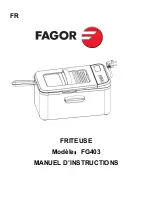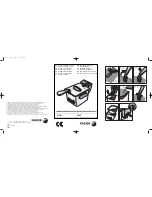
EN
4
19. The exhaust air must not be discharged into a flue which is used for exhausting fumes
from appliances burning gas or other fuels.
20. The appliance must not be installed behind a lockable door, a sliding door, or a door
with a hinge on the opposite side to that of the tumble dryer, in such a way that a full
opening of the tumble dryer door is restricted.
21. The tumble dryer can NOT be placed on top of a washing machine.
22. Oil-affected items can ignite spontaneously, especially when exposed to heat sources
such as in a tumble dryer. The items become warm, causing an oxidation reaction in
the oil. Oxidation creates heat. If the heat cannot escape, the items can become hot
enough to catch fire. Piling, stacking, or storing oil-affected items can prevent heat
from escaping and so create a fire hazard.
23. The appliance should not be overturned during normal use or maintenance.
24. Do not plug or unplug the product from the electrical outlet with wet hands.
25. Do not operate the appliance with a damaged cord or plug, or after the appliance
malfunctions or is dropped or damaged in any manner. Prior to operation, check the
device for physical damage.
26. The appliance is to be connected to a socket-outlet having earthing contact.
27. Install the tumble dryer into an easily accessible socket outlet located near the
appliance.
28. Install or store where it will not be exposed to temperatures below freezing or exposed
to water or weather, which could cause permanent damage and invalidate the warranty.
29. Keep the area around the exhaust opening and adjacent surrounding areas free from
the accumulation of lint, dust, and dirt. An obstructed port might reduce the airflow.
30. Thoroughly spin the laundry in the washing machine. The high spin speed can reduce
the drying time and save energy.
31. Make sure combustible sprays will not be close to the dryer when it is working, and
once the gas leaks, do not touch the plug, or start/pause it.
32. Do not wash or dry articles that have been cleaned in, washed in, soaked in, or spotted
with combustible or explosive substances (such as wax, oil, paint, gasoline, degreasers,
dry-cleaning solvents, kerosene, etc.).
33. Never attempt to operate this appliance if it is damaged, malfunctioning, partially
disassembled or has missing or broken parts, including a damaged cord or plug.
34. Do not allow children on or in the appliance. Close supervision of children is necessary
when the appliance is used near children.
35. Do not use the appliance when your hands are wet.
36. Do not store plastic, paper, or clothing that may burn or melt on top of the dryer during
operation.
37. The exhaust air must not be discharged into a flue which is used for exhausting fumes
from appliances burning gas or other fuels.
38. Do not dry articles containing rubber, plastic, or similar materials such as padded bras,
tennis shoes, galoshes, bath mats, rugs, bibs, baby pants, raincoats, plastic bags, or
pillows that may melt or burn. Some rubber materials, when heated, can under certain
circumstances produce fire by spontaneous combustion.
39. The door shall be opened only after the programme of the drying machine is completed.
Do not open the door before the programme is finished to avoid the human skin from
being scalded by hot steam or an overheated drying machine.
40. Remove all packaging materials before using the appliance. Keep the packaging
materials away from children they pose a risk of swallowing and suffocation.
41. The tumble dryer is not intended for outdoor use.
42. Before connecting the tumble dryer, ensure that the connection data on the data
plate (fuse rating, voltage, and frequency) match the mains electricity supply. If in any
doubt, consult a qualified electrician.
43. Do not connect the tumble dryer to the mains electricity supply by an extension
lead. Extension leads are a fire hazard and do not guarantee the required safety of the
appliance.





































